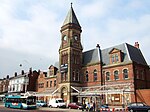Related Research Articles

The Liverpool and Manchester Railway (L&MR) was the first inter-city railway in the world. It opened on 15 September 1830 between the Lancashire towns of Liverpool and Manchester in England. It was also the first railway to rely exclusively on locomotives driven by steam power, with no horse-drawn traffic permitted at any time; the first to be entirely double track throughout its length; the first to have a true signalling system; the first to be fully timetabled; and the first to carry mail.

Earlestown railway station is a railway station in Earlestown, Merseyside, England, and one of the few "triangular" stations in Britain.

Edge Hill railway station is a railway station that serves the district of Edge Hill, Liverpool, England and is one of the oldest railway stations in the world
The Bolton and Leigh Railway (B&LR) was the first public railway in Lancashire, it opened for goods on 1 August 1828 preceding the Liverpool and Manchester Railway (L&MR) by two years. Passengers were carried from 1831. The railway operated independently until 1845 when it became part of the Grand Junction Railway.
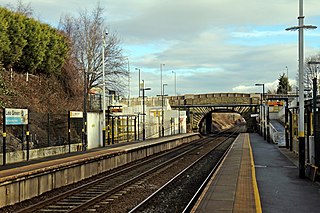
Lea Green railway station is in St Helens, Merseyside, England, three miles south of the town centre near the suburb of Clock Face. The station is on the electrified northern route of the two Liverpool to Manchester lines, 10+3⁄4 miles (17 km) east of Liverpool Lime Street. Northern Trains operates the station with Merseytravel sponsorship displaying Merseyrail signs. Constructed in 2000, the station has a park and ride car park fitted with charging points for electrically-powered vehicles, a modern CCTV security system and a booking office at street level.
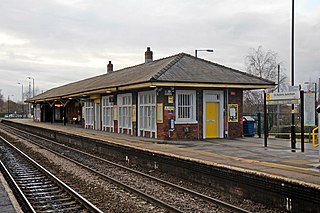
St Helens Junction railway station is a railway station serving St Helens, Merseyside, England. It is in Sutton, three miles southeast of St Helens town centre. The station is on the electrified northern route of the Liverpool to Manchester Line, 12 miles (19 km) east of Liverpool Lime Street. The station and all trains calling there are presently operated by Northern Trains.

The Liverpool–Wigan line is a railway line in the north-west of England, running between Liverpool Lime Street and Wigan North Western via St Helens Central station. The line is a part of the electrified Merseyrail Liverpool to Wigan City Line. The stations, and all trains serving it, are operated by Northern Trains, however the stations are branded Merseyrail using Merseyrail ticketing.

Hoscar railway station serves the rural village of Hoscar in the civil parish of Lathom, near the town of Burscough, Lancashire, England. The station stands split across Hoscar Moss Road. Only 1,060 passenger journeys started or ended at Hoscar in 2014/15. Eight trains a day call on weekdays in each direction, all provided by Northern Trains, who also manage the station.
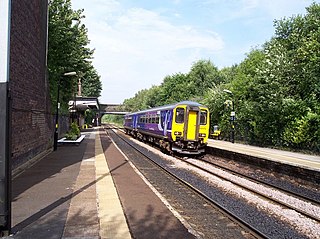
Roby railway station serves the village of Roby, Merseyside, England. It is located 5 miles (8.0 km) east of Liverpool Lime Street on the former Liverpool and Manchester Railway, and 1⁄2 mile (800 m) west of Huyton. It is operated by Northern Trains, as part of Merseyrail's electrified City Line to Manchester and Wigan North Western.

Huyton railway station serves Huyton in Merseyside, England. The station is an interchange between the Liverpool-Wigan Line and the northern route of the Liverpool-Manchester Line which diverge soon after the station. It is one of the busier stations on the lines and close to the shopping centre and bus station.

Rainhill railway station serves the district of Rainhill in Merseyside, England. It is situated on the electrified northern route of the Liverpool to Manchester Line, forming part of the Liverpool City Line. The station, and all trains serving it, are operated by Northern Trains on behalf of Merseytravel and are branded as Merseyrail services.
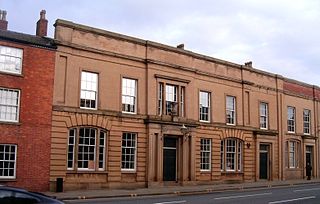
Liverpool Road is a former railway station on the Liverpool and Manchester Railway in Manchester, England that opened on 15 September 1830. The station was the Manchester terminus of the world's first inter-city passenger railway in which all services were hauled by timetabled steam locomotives. It is the world's oldest surviving terminal railway station. With tracks running at a second floor level behind the building, it could also be considered one of the world's first elevated railway stations.
Collins Green railway station was a railway station in Burtonwood, Warrington, England. It was in operation between 1830 and 1951.

Weaste railway station is a closed station on the Liverpool to Manchester line located between Seedley and Eccles in Salford.

A train station, railway station, railroad station or depot is a railway facility where trains stop to load or unload passengers, freight or both. It generally consists of at least one platform, one track and a station building providing such ancillary services as ticket sales, waiting rooms and baggage/freight service. If a station is on a single-track line, it often has a passing loop to facilitate traffic movements.
Kenyon Junction was a railway station at Kenyon near Culcheth in Warrington, England. The station was built at the junction of the Liverpool and Manchester Railway and the Kenyon and Leigh Junction Railway. It was situated in the historic county of Lancashire. The station opened in 1830 as Bolton Junction and closed to passengers on 2 January 1961 before closing completely on 1 August 1963. The junction fell out of use when the line serving Leigh was closed in 1969.
Westleigh or West Leigh was a station in Leigh, Greater Manchester, England on the Bolton and Leigh Railway line. Westleigh was situated within the historic county of Lancashire. Its station opened in 1831 and closed in 1954.
Parkside railway station was an original station on the Liverpool and Manchester Railway. It then became the interchange station between lines when the Wigan Branch Railway opened in 1832, moving to the physical junction of the two lines in 1838. The station continued as an interchange until being by-passed in 1847 when a west curve was opened to facilitate north–south links that did not go through the station. Traffic declined further after the Winwick cut-off opened in 1864 leading to closure in 1878.
Golborne South railway station was one of two stations serving the town of Golborne, to the south of Wigan.
The Kenyon and Leigh Junction Railway (K&LJR) was constructed to link the Bolton and Leigh Railway (B&LR), which terminated at the Leigh Branch of the Leeds and Liverpool Canal, with the Liverpool and Manchester Railway (L&MR) at Kenyon.
References
- ↑ Ferneyhough, Frank (1980). Liverpool & Manchester Railway 1830-1980. London: Book Club Associates. p. 101. ISBN 070918137X.
- ↑ Carlson, Robert (1969). The Manchester & Liverpool Railway Project 1821-1831. Newton Abbott: David & Charles. p. 198. ISBN 0715346466.
- ↑ Thomas, R (1980). The Liverpool & Manchester Railway. London: BT Batsford. p. 53. ISBN 0713405376.
- 1 2 Williams, W.H. (1922). "EARLY RAILWAYS IN SOUTH-WEST LANCASHIRE" (PDF). Transactions of the Historic Society of Lancashire and Cheshire: 141–143. Retrieved 20 February 2018.



